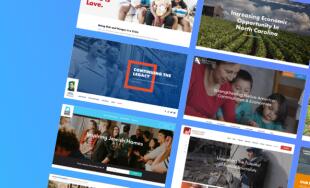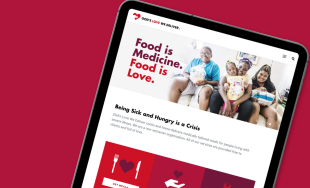As a nonprofit, you have various goals that need to be accomplished through your website, including increasing awareness, establishing partnerships, and proactively engaging with volunteers. Regardless of what your organizational goals and objectives may be, they can all be furthered by attracting qualified visitors to your site.
There are a number of different ways to drive new, relevant traffic to your site. Below are three practices that NMC and our nonprofit website design clients have had success with.

Search Engine Optimization
To grow any website successfully, it is important to start with the basics: search engine optimization (SEO). In short, SEO is a way to increase the quality and quantity of traffic to your website. Although the goal of SEO is to rank well on Google, Bing and various other search engines, it is also about understanding your target audience.
To begin, you should start by making a list of ten to twenty short words or descriptive phrases that are associated with your nonprofit. Examples of these could include “volunteer opportunities with children in Orange County” or “volunteer construction opportunities in Chapel Hill” just to name a few. Using these words and phrases as keystones, start to develop content around these topics and terms, publishing them to your blog. By seeding your site with this content, the overall site will start to rank better for these and the individual posts dedicated to specific terms can start to accrue targeted ranking.
It’s important to not stop at just creating an initial burst of content, but to keep up with it over the longterm, posting quality content consistently. Each new post gives you additional breadth to acquire new terms and depth of overall site content and opportunities to build links into other posts. With that in mind, it might be beneficial for you to create a content calendar for the next three, six, or even twelve months so that you have a plan in place for rolling out new content. Fresh, new content helps with more frequent indexing of your website and links getting built into your site from outside sources, leading to search engines viewing your website as authoritative and relevant.
From a technical standpoint, SEO refers specifically to the optimization of your website through things like mobile optimization, speedy delivery of content, using SSL certificates, clean markup, straightforward title tags and URLs, and more, so search engines can easily access and crawl your website. At NMC, we take SEO into consideration at the beginning of the process with design and continue to keep it top-of-mind through development by prioritizing our client’s website infrastructure, link structure, meta tags, image optimization, page speed...you get it. We make sure that our nonprofit clients have a strong SEO framework to buildout their SEO strategy with top-notch content.
As you begin to grow a database of content, host events, and partner with other organizations, you can implement linking to older blog posts and events which will help with your website’s SEO performance because it establishes site architecture and spreads link equity.

Leverage Social Media
At the minimum, make sure your nonprofit is active on the most popular social media platforms: Facebook, Instagram, and Twitter. Not only is this a great way to connect with your donors and volunteers, but it is a great way to share and link to the content that is being posted on your website. It also demonstrates you’re a dynamic and modern organization, which is essential when convincing potential donors to part with their hard earned dollars.
Content may look different for each of these platforms because what your audience responds well to on one platform may not be as relevant to the audience that you reach on another platform. NMC’s client, SECU Family House, does a great job of creating a community amongst their social media accounts by involving their followers in events. For example, on their Twitter page (@SECUFamilyHouse) they posted a graphic of a grocery list that represented the “most needed” non-perishable items for the week. Through retweets and additional communication, they were able to check off the items on their grocery list and fill their pantry with goods for the families that they serve. Not only is this a great way to bring your online community together but it also generates a lot of engagement on social posts.
God’s Love We Deliver, another NMC client, specifically leverages their Instagram account to raise awareness about fundraising events and to drive donor donations. Along with the advertisements for upcoming events, GLWD also incorporates volunteer stories, behind the scenes photos and insights, and shares their organization’s success through data like the number of meals served, volunteer demographics, and people served.
As you define your audience and develop a comprehensive social media strategy, your social content will start to come together. By incorporating a social media strategy to your overall organizational strategy, nonprofit organizations are likely to experience a boost in donations, brand awareness, and website traffic.

Start an Email Newsletter
We always encourage our nonprofit clients to add email marketing to their digital strategy if it is not already part of it. When done successfully, email marketing can have a great impact on nonprofit organizations and take the outreach and events that they are already doing to the next level. Email marketing is great because it helps in maintaining and deepening donor relationships and assists in achieving fundraising goals. Nonprofit organizations can also take advantage of email marketing to recruit volunteers, reconnect with lapsed donors, and to communicate important organizational and industry updates.
In the body and footer of your email, be sure to always include the basics like links to your website and social platforms, but you can and should also have a strong call-to-action for email subscribers to act upon that take them to a relevant and informational landing page on your website. If you don’t have a specific landing page that you want to point users to, make sure that you are pointing to content that you own. This goes back to helping your website’s overall SEO performance by getting people to that page and earning links and social shares from them - see how it all works together?
Email newsletters typically provide a quick, rather immediate boost of traffic that dies off within 24 hours. They’re short lived as people open them (or don’t) and then forget about them. So, we always recommend getting a bit more life out of your newsletter by also posting it on your blog, giving it an anchor on your site that can be referenced in the future and also accrue its own search engine value.
Bonus Tip: Track Everything
Over time, you should start seeing an increase in your website’s traffic. We recommend plugging an analytics tool into your website to help review the incoming traffic to your website. Google Analytics is one of the tools that we recommend to our clients because it is free and it details valuable data about website visitors like age, gender, interests, and location among many other essential insights. This type of data can help determine if your website’s content is reaching your targeted audience. There’s really no excuse to not have Google Analytics on your site.
Whether you have a brand-new website or an existing website, it is important to develop and implement a plan that generates new organic traffic to your website. There are a variety of different ways to organically grow the number of visitors your website receives but these three areas lay a proper foundation to leverage more advanced practices and ensure that you are reaching your intended audience.






Leave the first comment